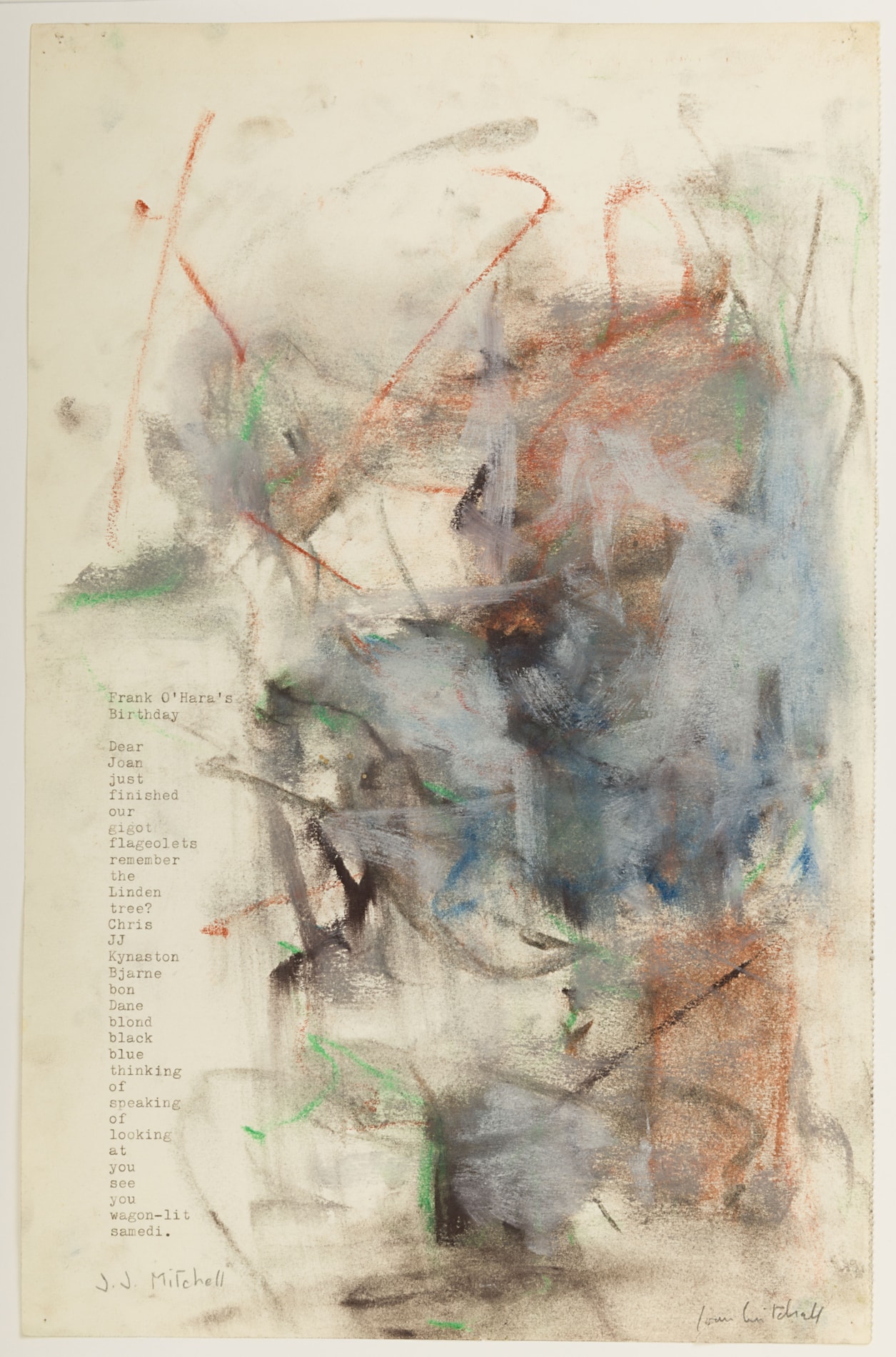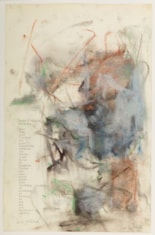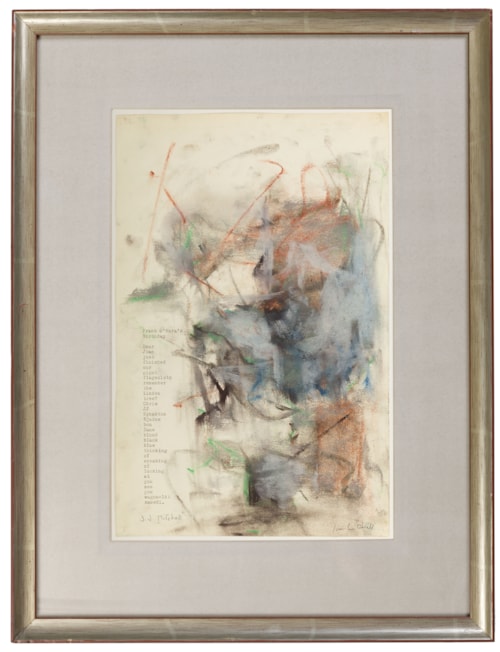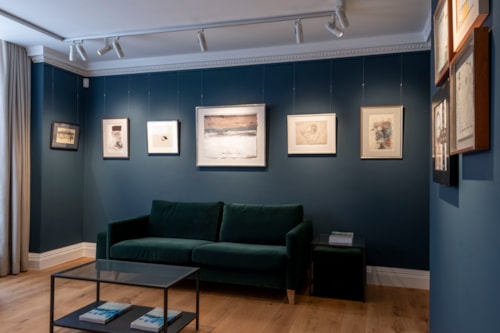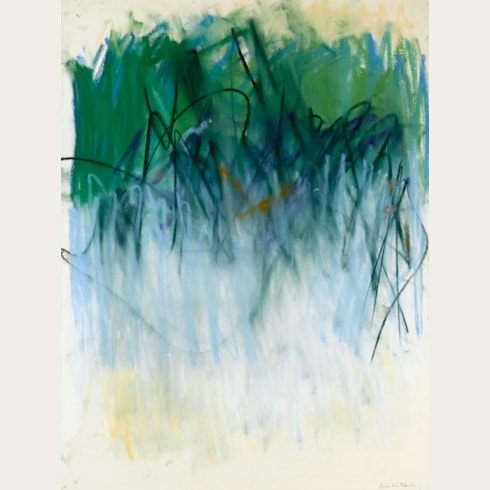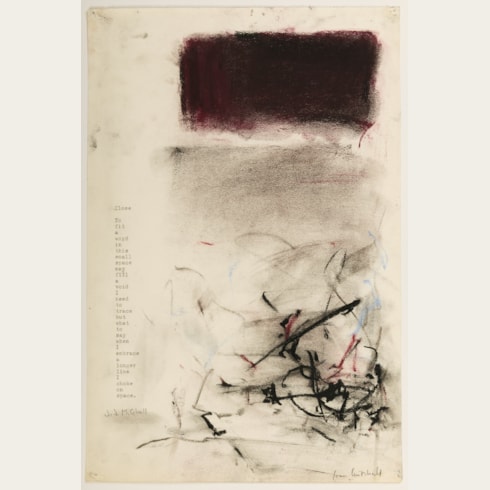Joan MITCHELL
(Chicago 1925 - Paris 1992)
Frank O’Hara’s Birthday
Pastel and typewriter ink on paper; a page from a sketchbook.
Signed Joan Mitchell in pencil at the lower right.
A poem by J. J. Mitchell entitled Frank O’Hara’s Birthday typewritten along the left edge of the sheet:
Frank O’Hara’s
Birthday
Dear
Joan
just
finished
our
gigot
flageolets
remember
the
Linden
tree?
Chris
JJ
Kynaston
Bjarne
bon
Dane
blond
black
blue
thinking
of
speaking
of
looking
at
you
see
you
wagon-lit
samedi.
Signed by the poet J. J. Mitchell in pencil at the lower left.
365 x 236 mm. (14 3/8 x 9 1/4 in.)
Signed Joan Mitchell in pencil at the lower right.
A poem by J. J. Mitchell entitled Frank O’Hara’s Birthday typewritten along the left edge of the sheet:
Frank O’Hara’s
Birthday
Dear
Joan
just
finished
our
gigot
flageolets
remember
the
Linden
tree?
Chris
JJ
Kynaston
Bjarne
bon
Dane
blond
black
blue
thinking
of
speaking
of
looking
at
you
see
you
wagon-lit
samedi.
Signed by the poet J. J. Mitchell in pencil at the lower left.
365 x 236 mm. (14 3/8 x 9 1/4 in.)
The present sheet is one of Joan Mitchell’s ‘poem pastels’ of 1975, and incorporates a poem by J. J. Mitchell (no relation to the painter), who stayed with the artist at her home, La Tour, in Vétheuil for several months between 1974 and 1975, during which time they collaborated on a series of pastel compositions featuring his poems. As Erin Kimmel has noted, the artist embarked on this group of pastels ‘when she was struggling to paint. Accustomed to switching modes when stuck, she asked J. J. Mitchell…a young writer who was moonlighting as her dog walker, confidant, and secretary of sorts, to use her mother’s Hermes typewriter to type up some of the poems he had written while staying at La Tour in Vétheuil. She took the pages and added pastel. Pleased with the result, she expanded the collection to include works that feature the poetry of other poet-friends, including Jacques Dupin, Pierre Schneider, and Chris Larson, as well as [James] Schuyler. Mitchell later objected to describing these works as collaborations. “I just took the poems,” she said.’
In these distinctive works, it was usually the painter who directed where on the sheet of paper the typewritten poem should go: ‘In a letter to Xavier Fourcade, Mitchell referred to these [poem pastels] as “color abstracts” that respond to the “shape of the poem itself.”’ In a letter to another poet, Karen Edwards, written at the end of 1975, Mitchell suggested that it was working on these ‘poem pastels’ that allowed her to return productively to painting: ‘Working with other people’s feelings – i.e. their poems, has helped a lot.’
As Kimmel has written of the poet J. J. (John Joseph) Mitchell (1940-1986), ‘A younger member of the New York School, J. J. deftly chronicled daily life at La Tour in his poems, moving seamlessly between comedy and pathos. From the fits and starts of Mitchell’s creative process to the comings and goings of Jean Paul Riopelle to the wisdom of Mitchell’s cherished German shepherd, Iva, they track the entire reality of Mitchell’s newly consolidated life in the country, including the dark, alcohol-drenched intimacy she shared with J. J.’
The present poem, Frank O’Hara’s Birthday, may have had a special significance for both Mitchells, who were each close friends of the poet and museum curator Frank O’Hara. Indeed, J. J. Mitchell was with O’Hara on the night of July 24th, 1966, when O’Hara was hit by a dune buggy on a beach on Fire Island in New York, dying the following day in hospital of internal injuries. Joan Mitchell later used the date of O’Hara’s death as the title of a suite of paintings dedicated to him. As Sarah Roberts has pointed out, ‘A former partner of O’Hara’s, J. J. wrote light, crisp poems that often directly addressed Mitchell and her dogs, like affectionate notes to a friend.’6 His poem Frank O’Hara’s Birthday is addressed to the painter, and is a tender evocation of the time they were spending together at Vétheuil, as well as of memories which both artist and poet shared of O’Hara and of mutual friends, on a day that would otherwise have been a cause for celebration (‘black / blue / thinking / of / speaking / of / looking / at / you’). Given the title of the poem, it is likely that it was written on or around March 27th, 1975, on what would have been O’Hara’s 49th birthday. Two further ‘poem pastel’ versions of Frank O’Hara’s Birthday, each with a different composition, are known.
Another example of Joan Mitchell’s and J. J. Mitchell’s ‘poem pastels’ from this 1975 series, entitled Blue, is today in the Museum of Modern Art in New York. Three others, all from the collection of the artist’s friend Joseph Le Sueur, appeared at auction in New York in 20079, while another, entitled Drowned, was sold at auction in Philadelphia in 2004. A further ‘poem pastel’ by J.J. and Joan Mitchell, entitled What Makes This, is in a private collection.
Seventeen of Joan Mitchell’s collaborative ‘poem pastels’, incorporating poems by both J. J. Mitchell and James Schuyler, were shown at the Tibor de Nagy Gallery in New York in 2002. As a New York Times review of the exhibition noted, ‘These paintings don’t necessarily illustrate the poems directly; in fact, in some cases it isn’t clear whether text or image came first. But more often than not the components share a mood.’ Of the same exhibition, another critic opined that ‘Joan Mitchell dismissed her works on paper - even painting-scale pastels of four-foot dimensions - as “lady paintings”…[however, in] petite and lovely sheets on which she combined her own pastel drawings with concrete poems by poet friends…Mitchell shows an unusually advanced sensitivity to balancing image and text on a page and making art of their interwoven imagery. The drawings are rather Zen-like, with floats and falls of icy or smoky color and hints of emerging form. They are subtle and delicate and at the same time frank and tough and sometimes angry (Not one bit ladylike!).'
In these distinctive works, it was usually the painter who directed where on the sheet of paper the typewritten poem should go: ‘In a letter to Xavier Fourcade, Mitchell referred to these [poem pastels] as “color abstracts” that respond to the “shape of the poem itself.”’ In a letter to another poet, Karen Edwards, written at the end of 1975, Mitchell suggested that it was working on these ‘poem pastels’ that allowed her to return productively to painting: ‘Working with other people’s feelings – i.e. their poems, has helped a lot.’
As Kimmel has written of the poet J. J. (John Joseph) Mitchell (1940-1986), ‘A younger member of the New York School, J. J. deftly chronicled daily life at La Tour in his poems, moving seamlessly between comedy and pathos. From the fits and starts of Mitchell’s creative process to the comings and goings of Jean Paul Riopelle to the wisdom of Mitchell’s cherished German shepherd, Iva, they track the entire reality of Mitchell’s newly consolidated life in the country, including the dark, alcohol-drenched intimacy she shared with J. J.’
The present poem, Frank O’Hara’s Birthday, may have had a special significance for both Mitchells, who were each close friends of the poet and museum curator Frank O’Hara. Indeed, J. J. Mitchell was with O’Hara on the night of July 24th, 1966, when O’Hara was hit by a dune buggy on a beach on Fire Island in New York, dying the following day in hospital of internal injuries. Joan Mitchell later used the date of O’Hara’s death as the title of a suite of paintings dedicated to him. As Sarah Roberts has pointed out, ‘A former partner of O’Hara’s, J. J. wrote light, crisp poems that often directly addressed Mitchell and her dogs, like affectionate notes to a friend.’6 His poem Frank O’Hara’s Birthday is addressed to the painter, and is a tender evocation of the time they were spending together at Vétheuil, as well as of memories which both artist and poet shared of O’Hara and of mutual friends, on a day that would otherwise have been a cause for celebration (‘black / blue / thinking / of / speaking / of / looking / at / you’). Given the title of the poem, it is likely that it was written on or around March 27th, 1975, on what would have been O’Hara’s 49th birthday. Two further ‘poem pastel’ versions of Frank O’Hara’s Birthday, each with a different composition, are known.
Another example of Joan Mitchell’s and J. J. Mitchell’s ‘poem pastels’ from this 1975 series, entitled Blue, is today in the Museum of Modern Art in New York. Three others, all from the collection of the artist’s friend Joseph Le Sueur, appeared at auction in New York in 20079, while another, entitled Drowned, was sold at auction in Philadelphia in 2004. A further ‘poem pastel’ by J.J. and Joan Mitchell, entitled What Makes This, is in a private collection.
Seventeen of Joan Mitchell’s collaborative ‘poem pastels’, incorporating poems by both J. J. Mitchell and James Schuyler, were shown at the Tibor de Nagy Gallery in New York in 2002. As a New York Times review of the exhibition noted, ‘These paintings don’t necessarily illustrate the poems directly; in fact, in some cases it isn’t clear whether text or image came first. But more often than not the components share a mood.’ Of the same exhibition, another critic opined that ‘Joan Mitchell dismissed her works on paper - even painting-scale pastels of four-foot dimensions - as “lady paintings”…[however, in] petite and lovely sheets on which she combined her own pastel drawings with concrete poems by poet friends…Mitchell shows an unusually advanced sensitivity to balancing image and text on a page and making art of their interwoven imagery. The drawings are rather Zen-like, with floats and falls of icy or smoky color and hints of emerging form. They are subtle and delicate and at the same time frank and tough and sometimes angry (Not one bit ladylike!).'
One of the foremost American Abstract Expressionist painters, Joan Mitchell produced a superb body of oil paintings, pastels and prints between the 1950s and the 1980s. Trained at the School of the Art Institute of Chicago, from which she graduated in 1947, Mitchell spent time living and working for brief periods in Mexico, Paris and the south of France before settling in New York. 1950 marks the true start of her career as a painter, with the early influence of artists such as Willem de Kooning, Arshile Gorky and Franz Kline visible in her work. She became a habitué of the Cedar Tavern in Greenwich Village, a popular meeting place for avant-garde artists and writers, and was friendly with such painters as de Kooning, Kline, Phillip Guston, Grace Hartigan and Helen Frankenthaler, as well as the poets Frank O’Hara and John Ashberry. In 1951 Mitchell took part in the seminal Ninth Street Show, organized by the artist’s group known as ‘The Club’ and the art dealer Leo Castelli. She had her first solo exhibition at Eugene Thaw’s New Gallery in New York in 1952, which was a critical if not commercial success, and the same year moved into a studio on St. Mark’s Place that she would keep until the early 1980s, even when living and working abroad.
Although Mitchell had a series of seven solo exhibitions at the Stable Gallery in New York between 1953 and 1965, by 1955 she had also begun to divide her time between New York and Paris. There she met and fell in love with the French-Canadian painter Jean-Paul Riopelle, with whom she would have a long and often fractious relationship. Her work began to be included in group shows and museum exhibitions, notably at the Jewish Museum in New York in 1957, the Venice Biennale in 1958, Documenta II in Kassel in 1959 and the Guggenheim Museum in New York in 1961. By this time her paintings had been acquired for the collections of both the Whitney Museum of American Art and the Museum of Modern Art in New York, as well as the Art Institute of Chicago. After 1959 Mitchell painted almost all of her work in France, and she was to spend the last thirty-five years of her career there. She had her first solo gallery show in Paris in 1962, and soon afterwards gained the support of the French dealer Jean Fournier, at whose eponymous Parisian gallery she was to exhibit between 1967 and her death in 1992.
When Mitchell’s mother died in 1966 she inherited part of a family trust, and the following year purchased a large house, ‘La Tour’, at Vétheuil, a town on the banks of the Seine, about sixty kilometres northwest of Paris, where the Impressionist painter Claude Monet had lived and worked between 1878 and 1881. Mitchell and Riopelle lived there together, and she had a separate large studio behind the house. The size of the studio enabled her to work on a grander scale than before, and the first works she produced there reflected, as has been noted, ‘the artist’s determination to allow her new, bucolic environment at Vétheuil to take her in new directions. Her move from Paris to the quiet and always beautiful two-acre property overlooking the Seine afforded her a new privacy and a physical connection with the landscape.’ The paintings Mitchell produced at Vétheuil have a more expansive approach - perhaps partly inspired by the changing landscape, with a broad view of the Seine river, that she could see from the windows of her new home – than the works she had produced in her Paris studio. She was also able to create works in a diptych or triptych format, and sometimes even larger, four-panel compositions, characterized by bright colours and bold, energetic brushstrokes. The first major retrospective of Mitchell’s paintings took place in 1974 at the Whitney Museum. Two years later she began to be represented in America by Xavier Fourcade, who showed her work at his Upper East Side gallery in New York until his death in 1987.
In 1979 Mitchell and Riopelle separated, and for some time thereafter she found herself unable to work on large canvases. She took a small studio in Montparnasse in Paris, and there began to work on a series of pastel drawings. As the scholar Jane Livingston has written of these small-scale works, ‘Mitchell’s work on paper was something she separated entirely from her painting activity and an endeavor about which she apparently had mixed feelings. She would say that her pastels were “lady paintings”. She did not want to be called a lady painter unless she was using the term herself, nor did she truly invest her deepest energies or intellect in these drawings…Although making drawings probably never rivaled printmaking in her own priorities, her place in Montparnasse gave her respite, and a way of continuing to work that seems to have been cyclically therapeutic. Ironically, her activity in this studio was literally toxic to her; she worked in a badly ventilated space, using powdery substances, including cadmium, which certainly exacerbated the lung problems that became more and more debilitating.’
With the loyal support of her dealers Jean Fournier in Paris and Xavier Fourcade in New York, Mitchell’s work was acquired by a network of private collectors in America and Europe. Soon after returning to large-scale painting around 1980, the artist had her first European museum exhibition at the Musée d’Art Moderne de la Ville de Paris. The early 1980s found her creating some of her finest works, notably the Grande Vallée series of twenty-one lyrical canvases painted during the period of just over a year, between 1983 and 1984. She also began producing a series of colour lithographs at the Tyler Graphics studio in upstate New York. Health issues and a cancer diagnosis, however, meant that there were long periods when the artist was unable to work as much as before. Another major retrospective exhibition travelled throughout the United States in 1988-1989 and Mitchell continued working on paintings and prints until the very end of her life. She died, of advanced lung cancer, in October 1992, at the age of sixty-six.
Although Mitchell had a series of seven solo exhibitions at the Stable Gallery in New York between 1953 and 1965, by 1955 she had also begun to divide her time between New York and Paris. There she met and fell in love with the French-Canadian painter Jean-Paul Riopelle, with whom she would have a long and often fractious relationship. Her work began to be included in group shows and museum exhibitions, notably at the Jewish Museum in New York in 1957, the Venice Biennale in 1958, Documenta II in Kassel in 1959 and the Guggenheim Museum in New York in 1961. By this time her paintings had been acquired for the collections of both the Whitney Museum of American Art and the Museum of Modern Art in New York, as well as the Art Institute of Chicago. After 1959 Mitchell painted almost all of her work in France, and she was to spend the last thirty-five years of her career there. She had her first solo gallery show in Paris in 1962, and soon afterwards gained the support of the French dealer Jean Fournier, at whose eponymous Parisian gallery she was to exhibit between 1967 and her death in 1992.
When Mitchell’s mother died in 1966 she inherited part of a family trust, and the following year purchased a large house, ‘La Tour’, at Vétheuil, a town on the banks of the Seine, about sixty kilometres northwest of Paris, where the Impressionist painter Claude Monet had lived and worked between 1878 and 1881. Mitchell and Riopelle lived there together, and she had a separate large studio behind the house. The size of the studio enabled her to work on a grander scale than before, and the first works she produced there reflected, as has been noted, ‘the artist’s determination to allow her new, bucolic environment at Vétheuil to take her in new directions. Her move from Paris to the quiet and always beautiful two-acre property overlooking the Seine afforded her a new privacy and a physical connection with the landscape.’ The paintings Mitchell produced at Vétheuil have a more expansive approach - perhaps partly inspired by the changing landscape, with a broad view of the Seine river, that she could see from the windows of her new home – than the works she had produced in her Paris studio. She was also able to create works in a diptych or triptych format, and sometimes even larger, four-panel compositions, characterized by bright colours and bold, energetic brushstrokes. The first major retrospective of Mitchell’s paintings took place in 1974 at the Whitney Museum. Two years later she began to be represented in America by Xavier Fourcade, who showed her work at his Upper East Side gallery in New York until his death in 1987.
In 1979 Mitchell and Riopelle separated, and for some time thereafter she found herself unable to work on large canvases. She took a small studio in Montparnasse in Paris, and there began to work on a series of pastel drawings. As the scholar Jane Livingston has written of these small-scale works, ‘Mitchell’s work on paper was something she separated entirely from her painting activity and an endeavor about which she apparently had mixed feelings. She would say that her pastels were “lady paintings”. She did not want to be called a lady painter unless she was using the term herself, nor did she truly invest her deepest energies or intellect in these drawings…Although making drawings probably never rivaled printmaking in her own priorities, her place in Montparnasse gave her respite, and a way of continuing to work that seems to have been cyclically therapeutic. Ironically, her activity in this studio was literally toxic to her; she worked in a badly ventilated space, using powdery substances, including cadmium, which certainly exacerbated the lung problems that became more and more debilitating.’
With the loyal support of her dealers Jean Fournier in Paris and Xavier Fourcade in New York, Mitchell’s work was acquired by a network of private collectors in America and Europe. Soon after returning to large-scale painting around 1980, the artist had her first European museum exhibition at the Musée d’Art Moderne de la Ville de Paris. The early 1980s found her creating some of her finest works, notably the Grande Vallée series of twenty-one lyrical canvases painted during the period of just over a year, between 1983 and 1984. She also began producing a series of colour lithographs at the Tyler Graphics studio in upstate New York. Health issues and a cancer diagnosis, however, meant that there were long periods when the artist was unable to work as much as before. Another major retrospective exhibition travelled throughout the United States in 1988-1989 and Mitchell continued working on paintings and prints until the very end of her life. She died, of advanced lung cancer, in October 1992, at the age of sixty-six.
Provenance
Acquired from the artist by a private collector, New York
Thence by descent.
Thence by descent.
Literature
Jenni Quilter, ‘“Love Is the Condition of Arriving at Infinity”: Joan Mitchell and Poetry’, in Sarah Roberts and Katy Siegel, ed., Joan Mitchell, exhibition catalogue, San Francisco and Baltimore, 2021-2022, p.197.

